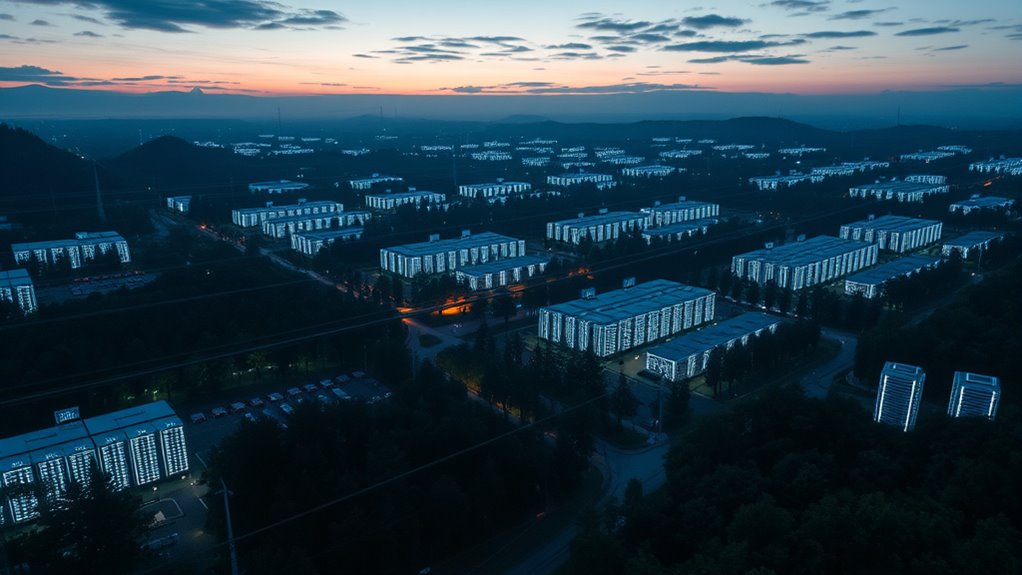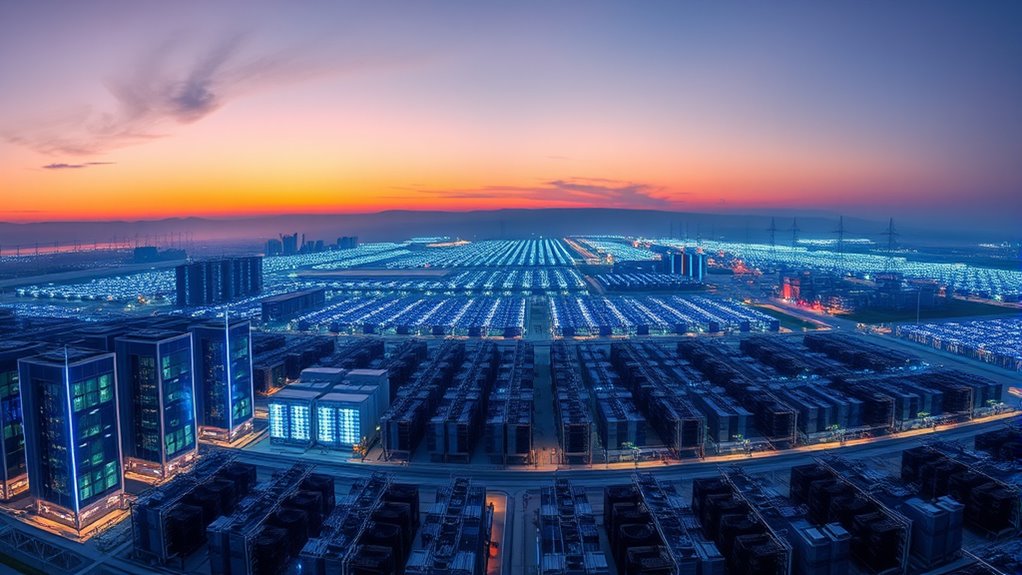As AI advances, data centers need more energy, risking a looming crisis if current consumption keeps rising. This surge can strain infrastructure and increase environmental impact. However, solutions like integrating renewable energy, improving hardware efficiency, and smart location choices can help. By adopting these strategies, you can support sustainable growth and reduce energy waste. Stay with us to discover how innovations are shaping a greener, more efficient digital future.
Key Takeaways
- AI’s increasing complexity raises significant energy consumption, stressing global data center infrastructure.
- Transitioning to renewable energy sources can mitigate environmental impacts of rising data demands.
- Improving data center efficiency through advanced cooling and hardware reduces overall power needs.
- Strategic location choices and smart workload management decrease cooling and operational energy use.
- Industry leadership and innovation are essential for developing sustainable, energy-efficient AI data center solutions.

As artificial intelligence continues to advance at a rapid pace, its energy demands are skyrocketing, threatening to strain data centers worldwide. These centers power AI models, process vast amounts of data, and support the digital infrastructure we rely on daily. But as their energy consumption grows, so does the environmental impact. To address this, you need to focus on adopting renewable solutions that can sustainably meet these rising demands. Wind, solar, and hydroelectric power are leading options that can considerably reduce carbon footprints. By integrating renewable energy sources into data center operations, you can help lower greenhouse gas emissions while ensuring reliable power supply. This shift isn’t just environmentally responsible; it’s also economically sensible in the long run, as renewable solutions often lead to lower energy costs over time.
However, simply switching to renewable sources isn’t enough. You must also prioritize energy efficiency within data centers. This means optimizing hardware, cooling systems, and overall infrastructure to minimize unnecessary energy use. Techniques like advanced cooling technologies, such as liquid cooling or free-air cooling, can dramatically reduce the amount of power needed to keep servers operating at ideal temperatures. Additionally, deploying energy-efficient servers and hardware that consume less power without sacrificing performance is essential. When you combine these strategies with renewable energy, you create a more resilient, sustainable, and cost-effective system capable of supporting AI’s growth without depleting resources or harming the environment.
Implementing energy-efficient practices goes beyond hardware improvements. It involves smarter data management and workload distribution to avoid over-provisioning and underutilization of resources. You should also consider the location of data centers—placing them in cooler climates can reduce cooling needs, further conserving energy. Incorporating automation and AI-driven monitoring can help identify inefficiencies and optimize power use in real-time, making your operations more sustainable. Moreover, understanding the role of renewable energy sources like wind and solar in the Green Living movement can motivate more sustainable choices across industries. These efforts collectively contribute to a more responsible approach, ensuring AI’s expansion doesn’t come at the expense of the planet.
Ultimately, meeting AI’s increasing power demands requires a proactive stance toward renewable solutions and energy efficiency. You have the power to influence the industry by supporting sustainable practices, investing in green energy infrastructure, and promoting innovations that make data centers more energy-conscious. As AI continues to grow, so does your opportunity to lead the charge toward a more sustainable digital future—one where technological progress aligns with environmental stewardship.
Frequently Asked Questions
How Can Renewable Energy Sources Meet Increasing Data Center Demands?
You can meet data center demands with renewable energy by investing in blockchain sustainability projects that promote clean energy use. Additionally, adopting cooling technology advances helps reduce energy consumption, making renewables more viable. When you combine these strategies, you create a more efficient, eco-friendly infrastructure that supports growth. This approach guarantees your data centers stay powered sustainably, reducing environmental impact while handling increasing data needs effectively.
What Innovations Are Reducing Ai’s Energy Consumption?
You can improve AI efficiency by adopting advanced algorithms that require less computation, reducing energy use. Innovations in data center cooling, like liquid cooling and improved airflow management, also cut down on energy consumption. These technologies help you operate AI systems more sustainably, lowering environmental impact while maintaining performance. By focusing on AI efficiency and effective cooling, you actively contribute to a greener, more energy-conscious data infrastructure.
How Will Governments Regulate Data Center Energy Use?
Like Icarus soaring too close to the sun, governments will craft regulations to curb datacenter energy use, balancing innovation with caution. You’ll see policies emphasizing energy efficiency, renewable sources, and transparency. Addressing privacy concerns and geopolitical tensions, authorities may impose stricter standards and reporting. These rules aim to prevent overreach while ensuring sustainable growth, guiding you toward a future where AI’s power won’t overshadow ethical and environmental boundaries.
What Are the Economic Impacts of Energy-Intensive AI Development?
You’ll notice that energy-intensive AI development impacts the economy through rising data pricing, making it more expensive for businesses to operate. Market volatility increases as demand for energy fluctuates, causing unpredictability in costs and investment returns. This can slow innovation and shift resources away from other sectors, ultimately affecting job creation and economic growth. Managing these costs requires careful planning to guarantee sustainable AI growth without destabilizing markets.
Can AI Help Optimize Global Energy Management?
Think of AI as a lighthouse guiding us through the fog of energy management. You can leverage AI efficiency to analyze and optimize energy consumption across grids, reducing waste and boosting sustainability. By improving data center sustainability through smarter cooling and resource allocation, you help create a more resilient energy infrastructure. Your actions using AI tools can turn complex energy challenges into manageable solutions, steering us toward a greener future.
Conclusion
As AI continues to grow, so does its energy appetite—by 2030, data centers could account for nearly 10% of global electricity use. This surge presents a real challenge: how will you balance technological progress with sustainability? If current trends persist, the energy demands may outpace our capacity to supply clean power, risking a crisis. Staying informed and advocating for greener solutions is essential—your choices can help shape a more sustainable AI future.










